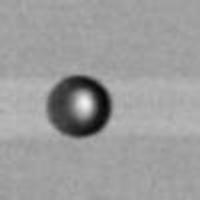当前位置:
X-MOL 学术
›
Opt. Lett.
›
论文详情
Our official English website, www.x-mol.net, welcomes your
feedback! (Note: you will need to create a separate account there.)
Ultrafast optical imaging at 2.0 μm through second-harmonic-generation-based time-stretch at 1.0 μm
Optics Letters ( IF 3.1 ) Pub Date : 2018-08-03 , DOI: 10.1364/ol.43.003822 Sisi Tan , Xiaoming Wei , Bowen Li , Queenie T. K. Lai , Kevin K. Tsia , Kenneth K. Y. Wong
Optics Letters ( IF 3.1 ) Pub Date : 2018-08-03 , DOI: 10.1364/ol.43.003822 Sisi Tan , Xiaoming Wei , Bowen Li , Queenie T. K. Lai , Kevin K. Tsia , Kenneth K. Y. Wong

|
The performance of ultrafast time-stretch imaging at long wavelengths (beyond 1.5 μm) has suffered from low detection sensitivity due to the increasing loss of optical dispersive fibers. Here, we report an ultrafast optical imaging system with a line scan rate of at the 2.0-μm wavelength window by combining second-harmonic generation (SHG) with the highly sensitive time-stretch detection at 1.0 μm. In this imaging system, the sample is illuminated by the pulsed laser source at 2.0 μm in the spectrally encoding manner. After SHG, the encoded spectral signal at 2.0 μm is converted to 1.0 μm and then mapped to the time domain through a highly dispersive fiber at 1.0 μm, which provides a superior dispersion-to-loss ratio of , larger than that of the standard fibers at 2.0 μm (typically ). These efforts make it possible for time-stretch technology not only being translated to longer wavelengths, where unique optical absorption contrast exists, but also benefitting from the high detection sensitivity at shorter wavelengths.
中文翻译:

通过基于第二谐波的时间拉伸以1.0μm进行2.0μm的超快光学成像
由于光色散光纤损耗的增加,长波长(超过1.5μm)的超快时间拉伸成像性能检测灵敏度低。在这里,我们报告了一种超快光学成像系统,其线扫描速率为通过将二次谐波产生(SHG)与1.0μm的高灵敏度时间拉伸检测相结合,在2.0μm的波长范围内实现了检测。在该成像系统中,样品以光谱编码方式被脉冲激光源以2.0μm的光照射。SHG之后,将2.0μm的编码光谱信号转换为1.0μm,然后通过1.0μm的高色散光纤映射到时域,从而提供了出色的色散损耗比。, 在2.0μm处比标准纤维大(通常 )。这些努力使得时间拉伸技术不仅可以转化为存在独特的光吸收对比度的更长波长,而且还得益于较短波长下的高检测灵敏度。
更新日期:2018-08-15
中文翻译:

通过基于第二谐波的时间拉伸以1.0μm进行2.0μm的超快光学成像
由于光色散光纤损耗的增加,长波长(超过1.5μm)的超快时间拉伸成像性能检测灵敏度低。在这里,我们报告了一种超快光学成像系统,其线扫描速率为通过将二次谐波产生(SHG)与1.0μm的高灵敏度时间拉伸检测相结合,在2.0μm的波长范围内实现了检测。在该成像系统中,样品以光谱编码方式被脉冲激光源以2.0μm的光照射。SHG之后,将2.0μm的编码光谱信号转换为1.0μm,然后通过1.0μm的高色散光纤映射到时域,从而提供了出色的色散损耗比。, 在2.0μm处比标准纤维大(通常 )。这些努力使得时间拉伸技术不仅可以转化为存在独特的光吸收对比度的更长波长,而且还得益于较短波长下的高检测灵敏度。











































 京公网安备 11010802027423号
京公网安备 11010802027423号